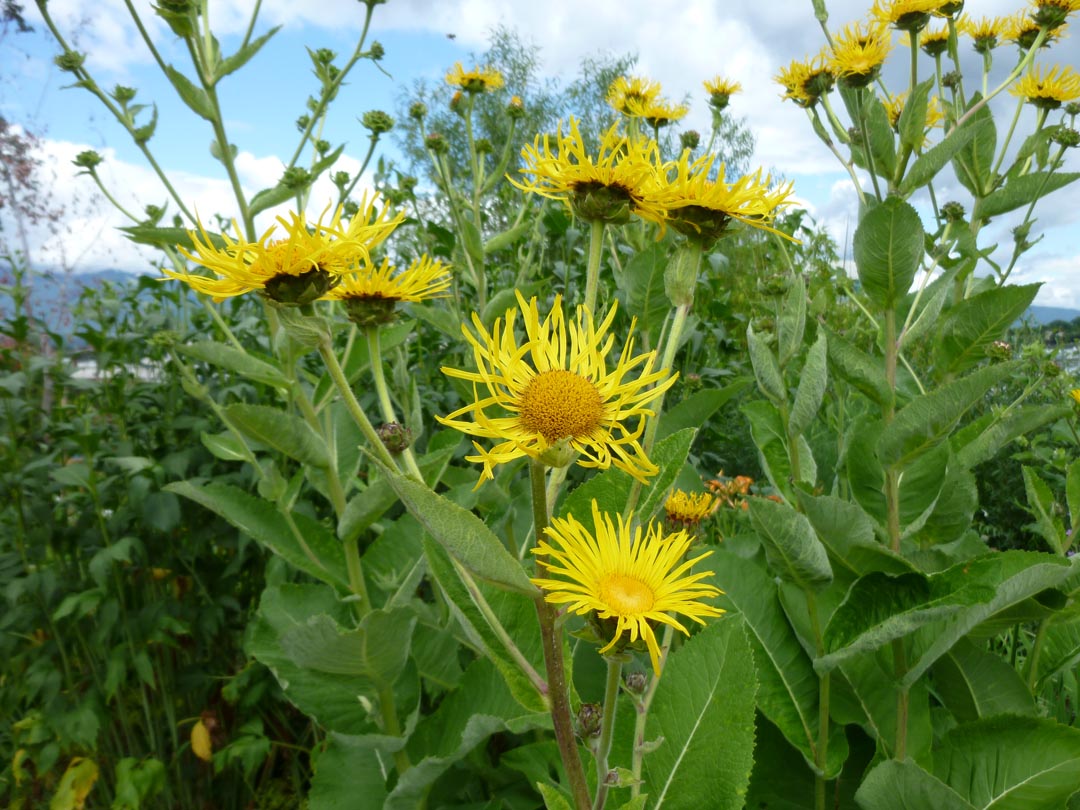
Common Name: Elecampane, Aunee, tu mu xiang, Horse-Heal, Elfdock, Yellowhead, Horseheal, Yellow Starwort
Latin Name: Inula helenium
Family: Asteraceae (Compositae)
Parts Used: Root (Ideally 3 year old roots)
Plant Identification & Harvesting: Inula Helenium is a rhizomatous perennial growing up to 1.5m (5ft) tall by 1 m (3ft 3in) wide. They are native to Europe and northern Asia, but have naturalised in fields, roadsides and other disturbed sites and waste places in parts of eastern North America from Nova Scotia to Minnesota south to North Carolina and Missouri.The leaves are coarse, toothed, and hairy (thin hair on top and velvety hair underneath). The basal leaves are ovate-elliptic and can extend out 1-2’ on petioles that can be up to 1’ long. The stem leaves are ovate-lanceolate and are much shorter and sessile. The stalk is thick, strong, and rigid, and the stem leaves decrease in size as they go up the stalk. Sunflower-like flowers (2-3″ diameter), each subtended by broad floral bracts, feature numerous very thin, scraggly yellow rays which surround a central disk of darker yellow tubular flowers. Flowers bloom July-September. The root has an incredible aromatic scent that is somewhat floral and fruity. Harvest roots by digging once the plant has died back in November.
Energetic properties: Drying, Warming, Stimulating (but some relaxant properties)
Tastes: Bitter, Aromatic, Pungent, Slightly Acrid
Herbal Action: Anthelmintic, Antimicrobial, Antirheumatic, Aperient, Appetite Stimulant, Astringent, Bitter, Carminative, Cholagogue, Depurative, Diaphoretic, Diuretic, Expectorant, Febrifuge, Hepatic, Relaxant, Stomachic
Uses:
Inula is wonderful at clearing mucus out of the whole respiratory system. They are most notably a stimulating expectorant, which are primarily used to treat moist, productive coughs. There are also some relaxing expectorant qualities present, which help to soothe more spasmodic coughs. Sajah Popham recommends “using Elecampane when there is a cold, damp, phlegmatic cough with mucus that is difficult to expel” and/or “when your cough won’t go deep enough to get all the stagnant mucus out from your lungs.” David Hoffman says “This remedy provides a good illustration of the complex and integrated way herbs work. The mucilage has a relaxing effect, while the essential oils bring about stimulation, so the herb both soothes irritation and promotes expectoration.” Inula can also help with a runny nose, because they decrease the secretion of mucus due to their astringency and affinity for the upper respiratory system.
Inula is able to improve digestion and support many elements of the digestive tract. As a warming carminative and bitter herb, they help to stimulate appetite, get digestive juices flowing, and reduce gas and bloating. Their high inulin content means they are prebiotic, supporting the growth of healthy bacteria in your gut. Their inulin content also means they support digestion by assisting the pancreas. According to David Winston, “Inula also acts on the intestines as a remedy for Giardia and other intestinal parasites.”
Inula can support your immune system and has broad spectrum antimicrobial properties. They are great for bacterial infections, especially when the mucus is yellow to green and according to Ruthie Hayes, useful in treating Candida overgrowth in the gut and other fungal infections. You can also use Inula as a topical antiseptic, but always do a test patch because the plant has been known to cause contact dermatitis in some people.
Inula also has the ability to make you sweat and this is very useful in feverish conditions, especially when there is a cough present and the person is cold and shivering. Inula brings the blood to the surface of the skin, opens the capillary beds, and warms the person so they can produce sweat and break the fever.
Constituents: Polysaccharides ( up to 44% Inulin), Sesquiterpene Lactones (Alantolactone, Isoalantolactone), Sterols, Resin, Mucilage, Volatile Oils
Safety Considerations: Class 1b – Use in formulations only, up to 50%. Not recommended during pregnancy. Use with caution during lactation or if taken concurrently with sedative or mood-altering medications. Mild irritant to the mucous membranes of the digestive tract in some sensitive individuals. May cause allergic reactions in people sensitive to plants of the Asteraceae family.
Preparations:
Tincture: of the roots made at 1:2 dried or 1:5 fresh in 40-60% alcohol. Dosage is 1-2 ml 3X/day. Best in formulation.
Infusion: made with 1 tsp shredded root per cup of cold water. Let stand for minimum 8 hours. Heat and take hot three times a day.
Decoction: strong decoction, 2-6oz, three times a day.
Syrup: a strong decoction, reduced by half, and add an equal amount of honey. Take 1-3 tsp 4x/day.
Candied
Bibliography
Hoffman, D. (2003). Medical Herbalism: The Science and Practice of Herbal Medicine. Healing Arts Press.
Brinker, F. (2010). Herbal Contraindications and Drug Interactions Plus Herbal Adjuncts with Medicines. Eclectic Medical Publications.
Popham, S. (2023). Elecampane: The Deep Breather. Retrieved from The School of Evolutionary Herbalism: https://www.evolutionaryherbalism.com
L. (2005). Inula helenium, Elecampane. Retrieved from Plants for a Future: https://pfaf.org
Hayes, R. (2015). Elecampane Monograph. Retrieved from Eclectic School of Herbalism. https://eclecticschoolofherbalmedicine.com
Vertolli, M. (2012). Advanced Herbal Therapeutics & Materia Medica. Living Earth School of Herbalism.
Medical Disclaimer: The information provided throughout this site is for educational purposes only and is not to be regarded as substitute for professional medical advice and should not be relied on as health or personal advice. The information provided is not intended to diagnose, treat, cure or prevent any disease. Always seek the guidance of your qualified health professional with any questions you may have regarding your health or a medical condition.